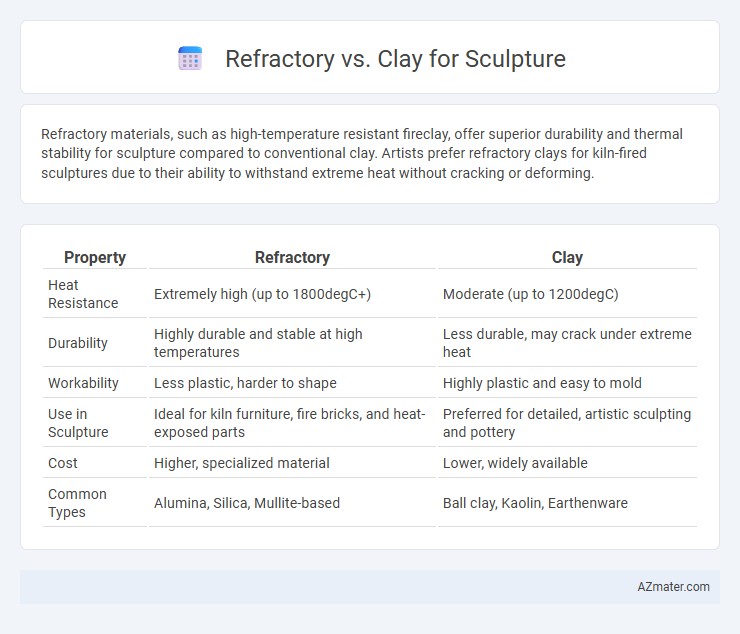Refractory materials, such as high-temperature resistant fireclay, offer superior durability and thermal stability for sculpture compared to conventional clay. Artists prefer refractory clays for kiln-fired sculptures due to their ability to withstand extreme heat without cracking or deforming.
Table of Comparison
| Property | Refractory | Clay |
|---|---|---|
| Heat Resistance | Extremely high (up to 1800degC+) | Moderate (up to 1200degC) |
| Durability | Highly durable and stable at high temperatures | Less durable, may crack under extreme heat |
| Workability | Less plastic, harder to shape | Highly plastic and easy to mold |
| Use in Sculpture | Ideal for kiln furniture, fire bricks, and heat-exposed parts | Preferred for detailed, artistic sculpting and pottery |
| Cost | Higher, specialized material | Lower, widely available |
| Common Types | Alumina, Silica, Mullite-based | Ball clay, Kaolin, Earthenware |
Introduction to Sculpting Materials
Refractory materials, known for their high heat resistance, are essential for sculptures requiring kiln firing and durability, while clay offers versatile workability suitable for detailed modeling and hand-building techniques. Refractory materials such as fireclay withstand extreme temperatures without cracking, making them ideal for functional ceramics and outdoor sculptures. In contrast, traditional clay types like earthenware and stoneware provide a softer medium perfect for sculptors focusing on fine textures and expressive forms.
What is Refractory Material?
Refractory material is a type of substance designed to withstand extremely high temperatures without melting or breaking down, making it essential for processes like metal casting and kiln construction. These materials typically include firebricks, ceramic fibers, and specialized clays capable of resisting thermal shock and chemical corrosion. In sculpture, refractory materials enable artists to create molds and supports that maintain structural integrity during high-heat firings, unlike standard clay which may crack or deform under such conditions.
What is Clay for Sculpture?
Clay for sculpture is a natural, malleable material composed primarily of fine-grained minerals like kaolinite, which becomes pliable when mixed with water and hardens upon drying or firing. It allows artists to shape intricate details and is favored for its versatility, ease of use, and ability to retain textures and impressions. Unlike refractory materials designed for high-temperature resistance, sculptural clay is specifically formulated for artistic modeling and firing in conventional kilns.
Key Differences Between Refractory and Clay
Refractory materials withstand extremely high temperatures without melting or deforming, making them ideal for kiln linings and industrial applications, whereas clay is primarily composed of natural earth minerals used for sculpting and firing at lower temperatures. Clay softens and hardens when fired in a kiln, allowing for detailed artistic manipulation, while refractory materials remain rigid and maintain structural integrity under thermal stress. The key difference lies in their thermal resistance and purpose: clay is designed for creative modeling and firing, whereas refractory materials are engineered for heat resistance and durability in high-temperature environments.
Properties of Refractory vs Clay
Refractory materials exhibit high heat resistance, low thermal conductivity, and excellent durability, making them ideal for sculptures intended to withstand extreme temperatures without cracking or warping. Clay, while versatile and easy to shape, has lower heat resistance and can be prone to shrinkage, cracking, or deformation during firing unless properly formulated or combined with specific additives. The choice between refractory materials and clay depends on the sculpture's functional requirements, with refractory offering superior thermal stability and clay providing ease of manipulation and artistic detail.
Sculpting Techniques: Refractory vs Clay
Refractory materials allow for high-temperature kiln firings without cracking, ideal for complex sculptures requiring durability and heat resistance, while clay offers greater malleability and ease of manipulation for detailed hand-building and wheel-working techniques. Sculptors using refractory must account for its denser texture and slower drying times, whereas clay provides more flexibility with various surface treatments and finishes. Mastery of refractory techniques often involves precision in slip casting and mold-making, contrasting with the intuitive shaping and carving methods common in clay sculpture.
Applications in Sculpture
Refractory materials excel in high-temperature sculpture applications such as kiln linings and molds due to their resistance to thermal shock and durability, making them ideal for metal casting and glass art. Clay, especially ceramic clay, is favored for hand-building, wheel-throwing, and detailed sculptural work because of its plasticity and ease of shaping at lower firing temperatures. Artists often combine refractory materials with clay to create hybrid sculptures that benefit from both materials' thermal resilience and artistic versatility.
Advantages and Disadvantages
Refractory clay offers high heat resistance and durability, making it ideal for sculptures subjected to extreme temperatures and outdoor environments, but it tends to be heavier and less malleable than traditional clay. Traditional clay is easier to mold and more accessible for detailed work, suitable for indoor sculptures, but it lacks the thermal strength and may crack or degrade when exposed to high heat. Choosing between refractory and clay depends on the sculpture's intended use, environmental exposure, and required mechanical properties.
Choosing the Right Material for Your Project
Choosing between refractory and clay for sculpture hinges on the project's firing temperature and durability requirements. Refractory materials withstand extreme heat up to 3000degF, ideal for kiln linings and metal casting molds, whereas traditional clay suits lower temperature firings around 2300degF, perfect for detailed ceramic art. Prioritize refractory for thermal resistance and structural strength, while clay offers versatility and ease of manipulation for artistic expression.
Conclusion: Refractory or Clay for Sculpture?
Refractory materials offer superior heat resistance and durability, making them ideal for sculptures exposed to high temperatures or outdoor conditions. Clay, while easier to shape and more accessible for beginners, lacks the thermal stability required for long-term durability in harsh environments. Choosing refractory materials ensures longevity and structural integrity, whereas clay suits projects focused on artistic flexibility and lower firing temperatures.

Infographic: Refractory vs Clay for Sculpture
 azmater.com
azmater.com